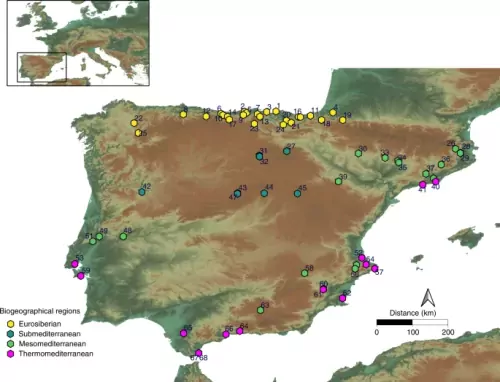
Abstract
The Middle to Upper Palaeolithic transition was a pivotal moment in human history, marking the disappearance of Neanderthals and the survival of modern humans. To better understand these events, we have quantified how changes in stadial (alternating cold/warm periods) and interstadial conditions impacted biomass availability for secondary consumers during this time period. By using advanced techniques such as summed probability distributions and Bayesian age modelling coupled with generalized dynamic vegetation model simulations combined with macroecological models validated by present-day observations, our research has revealed some fascinating insights into what ultimately led to Neanderthal extinction while paving way humanity's longevity through today.
Main
The replacement of Homo neanderthalensis populations by anatomical modern humans (AMHs) is a turning point in human evolution and one of the most debated issues in Palaeolithic research. Despite the difficulties of disentangling the driving forces in such population turnover, an increasing amount of research points out that the abrupt climatic shifts during Marine Isotope Stage 3 (MIS 3; ~60–30 kyr BP) played a key role in the Middle to Upper Palaeolithic transition (MUPT) in Europe1,2,3,4. However, the underlying mechanisms linking climatic changes and the spatiotemporal patterns of Neanderthals’ disappearance are still unknown.
The Iberian Peninsula is a crucial site in the exploration of Neanderthals’ mysterious disappearance. Composed of two distinct biogeographical regions -the Eurosiberian region to the north and west, and Mediterranean region to south east- behaviorial changes that preceded their eventual decline can be traced here. As evidence suggests cooling temperatures during MIS 3 led to increased aridity, with some believing this contributed significantly towards climate change woes for our ancient human relatives.
The current study explored the effects of MIS 3 stadial and interstadial conditions on plant and herbivore biomass in Iberia, as well as investigated how temporal and spatial patterns of MUPT may have been affected by alterations in ecosystem productivity. To do this, a combination of OLE models, SPDs from archaeological assemblages along with Bayesian age modelling was used to create an updated timescale for each biogeographical region's MUPTs between 55-30kyr BP. This timeline accompanied a generalized dynamic vegetation model which incorporated climate inputs from an atmospheric general circulation model allowing researchers to trace NPP during these periods - uncovering untold stories about environment changes affecting plants & animals at that time.
Results
Biogeographical differences in herbivore and plant biomass
The analyses performed in the current study focused on the four main biogeographical regions of Iberia: the Eurosiberian region in the temperate areas of the North; the Supramediterranean in the Northern Plateau and Iberian System; and the two bioclimatic belts that make up the Mediterranean region (the Mesomediterranean and the Thermomediterranean regions (for details, see the ‘Geographic settings’ subsection in the Methods)) (Fig. 1). In the interstadial periods, the highest NPP mean is observed in the Eurosiberian region (0.33 kg km−2 yr−1), followed by the Mesomediterranean (0.31 kg km−2 yr−1), Supramediterranean (0.26 kg km−2 yr−1) and Thermomediterranean (0.25 kg km−2 yr−1) regions








